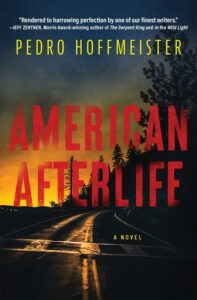When I was in the first stages of writing my new novel American Afterlife, I didn’t know how to write a great thriller. In fact, I didn’t even know how to write an average thriller. I wasn’t sure how to structure a thriller or which elements would make it fit into the genre. I was completely ignorant when it came to arcs, themes, and motifs. I didn’t know what made a narrator a great thriller narrator, and I also didn’t know how to captivate an audience while scaring them a little bit.
I’d written and published novels with Random House, Simon & Schuster, etc., but my novels were literary or young adult, eco, or—in once case—a gothic, crime mystery. Critics always used words like “gritty” or “dark” when they reviewed my books, but it wasn’t until my agent told me that my new book draft was a “quasi-thriller” that I thought, “Well, how do you make a quasi-thriller into a full-blown thriller?”
That was a big question, and I was far from equipped to answer it.
I had another problem as well: My book draft was already a post-apocalyptic novel. In my story, a city is destroyed by a devastating earthquake, and my protagonist is searching the ruined city for her mother as a cult hunts for her. So how could I combine two genres and make my book into a thriller and a post-apocalyptic novel as well? And would that wreck the book or could it make it even better?
I waded in, full of doubt and skepticism. But thankfully, we all have the same resources at our disposal: thousands of well-written novels at our local libraries and bookstores. So I got to work, started buying and reading the following novels, taking notes and trying to acquire the necessary skills to combine these two complicated genres.
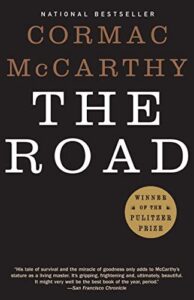
The Road by Cormac McCarthy
Since I’d already read the brilliant off-screen violence of Flannery O’Connor’s “A Good Man Is Hard To Find,” I set out to study Cormac McCarthy, the literary grandchild of O’Connor. There’s the obvious thriller No Country For Old Men, and I’d read that before, but I really wanted to focus on McCarthy’s Pulitzer Prize winning novel The Road since it’s probably the closest book to a post-apocalyptic thriller. Therefore, starting with the big picture, I got to see what the finished product might look like.
I read The Road twice, my first reading at a quick pace, and the second reading at a slower, note-taking pace. The first reading impacted me emotionally, taught me how a combo genre should feel, but the second reading taught me to pay attention to the smaller details. I asked questions like, “What moments of backstory add tension to this novel?” “How does McCarthy use travel to raise the stakes?” And “Why is the reader so terrified throughout the novel that the boy will be left all alone?” Also, “What separates the two main characters from everyone else in this destroyed landscape?”
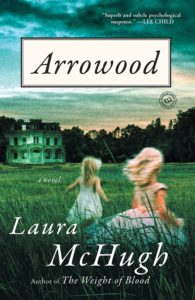
Arrowood by Laura McHugh
Next I wanted to be as scared as possible, and to learn how to focus on one location. With those two things in mind, I read Arrowood by Laura McHugh. McHugh won an international thriller award for her novel The Weight Of Blood, but her novel Arrowood is even more terrifying. It causes the reader to question and doubt over and over, and it brings the reader back to the same house repeatedly without becoming boring.
I noticed how we’re given different pieces of the story at different times, and that each addition to the layers adds complexity to the readers’ growing fears. We also have multiple possible suspects in this novel, and all of the suspects seem capable of murder.
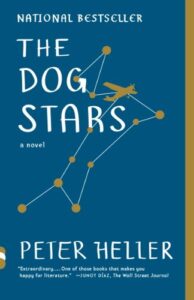
The Dog Stars by Peter Heller
Then I went a different direction, away from thriller. I’d already read Emily St. John Mandel’s Station Eleven (which I loved), and I’d heard that Heller’s similar novel was an even better book. (Strange side note I discovered through research: both post-apocalyptic airport novels were edited by the same editor at Random House and in the exact same year.)
So I analyzed the post-apocalyptic elements, comparing my draft to both Station Eleven and to Heller’s The Dog Stars. I discovered that Heller’s post-plague novel is the perfect example of a book where a flawed character becomes the reader’s favorite. I read this book twice as well, wanting to know how Heller makes the reader love both Hig and Bangley, how Heller makes abrasive and imperfect people into the readers’ favorite characters.
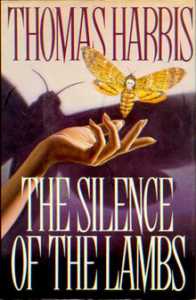
The Silence Of The Lambs by Thomas Harris
Full disclosure: I was so afraid of this story that I once walked home three miles from a high school party because people wanted to watch this film all together. I couldn’t handle it.
But the amazing thing about The Silence Of The Lambs is how Harris creates abject terror in the psychological scenes rather than the violent moments. Violence is less terrifying in his story, and that’s a skill.
As I revised my novel, my agent said I needed to “write scary” while avoiding scenes of “torture porn.” I’d never heard the term “torture porn,” but I learned that crossing this line is what divides many thrillers from similarly-themed horror novels. And the former is scarier than the latter if done well. So I examined The Silence Of The Lambs, and thought about how Harris straddles that line.
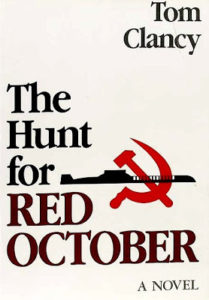
The Hunt For The Red October by Tom Clancy
It’s never a bad idea to examine a classic, and Clancy’s novel was on dozens of “best thriller ever” lists on the internet. Plus, Clancy was combining genres in this book. The Hunt For The Red October is a spy/action/political/thriller, a combo of FOUR genres all in one, and any time an author is able to do so many things in one book, that’s an author that aspiring writers should examine and pay attention to.
So I read Clancy’s novel slowly, and thought about all of the interwoven characters, and what they each did as vehicles of plot. Because—in the end—a thriller is only a great thriller if it has an engaging, mesmerizing plot, and the characters need to make this plot better. Having written literary novels in the past—where plot is a secondary concern—I knew that plot was something I needed to work on.
With the knowledge and tools gained from these five books, now I needed to go out and write a great crossover thriller. Make big revisions. Cut and rewrite. Cut and rewrite again. It was scary, and I failed often. But then—thankfully—I had an incredible editor.
***


